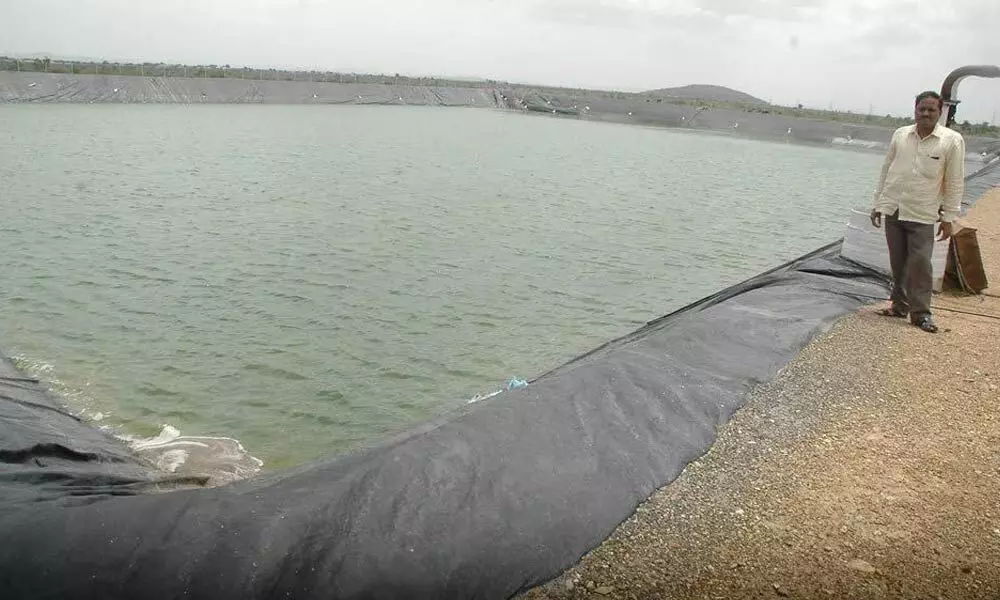Live
- They always want me to win, and now I feel lucky to have been offered a story like ‘Zebra’: Satyadev Kancharana
- ‘Democracy first, humanity first’: PM Modi in Guyana's parliament on two countries' similarities
- PKL Season 11: Telugu Titans register third straight win to top standings
- Is Pollution Contributing to Your COPD?
- NASA Unveils Underwater Robots for Exploring Jupiter's Moons
- Additional Central forces arrive in violence-hit Manipur
- AR Rahman and Saira Banu’s Divorce: Legal Insights into Common Issues in Bollywood Marriages
- 82.7 pc work completed in HPCL Rajasthan Refinery area: official
- Curfew relaxation extended in 5 Manipur districts on Friday
- Tab scam prompts Bengal govt to adopt caution over fund disbursement
Just In
DWMA water conservation steps yielding results in Anantapur


A pond in Tadipatri conserved with water
- Measures implemented since 2019-20 on war footing by creating 39,245 conservation assets result in saving 7.92 TMC of water in the district
- Over one lakh rainwater harvesting structures have been created and 19,008 borewells got recharged, thereby 19,231 hectares additional extent of land irrigated
Anantapur: A district written off once by observers as a desert in making had has graduated into a horticulture hub by sheer water conservation initiatives taken up by the district administration.
Once described by ICAR scientists as a desert in-the making with agriculture fields turning into sand dunes and satellite pictures supporting the fears, the district has gone a long way in achieving success on the water conservation front. A host of water conservation initiatives and creation of water conservation assets resulted in ground water recharge to the order of 11.23 tmc and water conservation of 7.92 tmc stored in conservation structures.
District Collector Gandham Chandrudu and DWAMA Project Director Venugopal Reddy told The Hans India on the occasion of 'World Water Day' that awards bagged by DWMA from the Central agencies affirms measures implemented since 2019-20 on a war footing by creation of 39,245 conservation assets resulted in saving 7.92 TMC of water considered to be more precious than gold metal.
As many as 1,00,040 rainwater harvesting structures were created during recent years and 19,008 borewells got recharged, thereby 19,231 hectares additional extent of land irrigated. As many as 149 tanks and check dams were filled. The groundwater recharge was to the order of 11.23 TMC and borewells recharged was 80,790. An indirect ayacut expansion of 81,732 hectares was registered. The total average water levels rise is 3.77 metres in HNSS and HLC canal influence zone.
Recalling the past scenario, Venugopal stated that the pre-conservation picture was one of gloom with a history of 100 years of drought and severe drought conditions for 15 consecutive years until 2018. Erratic and scanty rainfall conditions resulted in crop failures every year and distress migration by farmers and agriculture labour and indebtedness of farmers. Some farmers who could not see light at the other end of the tunnel resorted to panic suicides.
Groundwater table plummeted to alarming levels and even deep drilling of bores by farmers failed to yield positive results. Fodder scarcity was also the biggest challenge faced by the district. The rainfall was the lowest in the state and second lowest of 552.3 mm in the country. The groundwater levels plummeted from 10.58 meters in July 2002 to 26.82 meters by July 2019.
Forests in the district being thin and scanty, the administration has launched massive plantation, greening of hills, barren hill afforestation(BHA), gap filling plantation, institutional plantation, avenue plantation, bund plantation under MGNREGS and Integrated Watershed Management Programme (IWMP) during 2019-20 apart from tying up with Social and Territorial Forest departments to achieve improved plant population and greenery.
Construction of soil moisture works like peripheral trenches, staggered trenches, water absorption trenches, continuous contour trenches, rockfill dams, sunken pits, soak pits were also taken up under convergence with MGNREGS for development of forest area.
Totally 3554.95 kms of avenue plantations with 14.39 lakh plants and 16,697 hectare extent of land developed with horticulture, block plantation, greening of hillocks and barren hill afforestation taken up by planting 37.25 lakh plants. 50,000 seed balls were broadcasted in the district to improve hillock greenery.
Water conservation appeared to be the only hope of the government and stakeholders who felt the dire need to undertake measures for water conservation and creation of permanent conservation assets. The district administration succeeded in lifting the district out of economic morass created by scarce water resources sans conservation measures.

© 2024 Hyderabad Media House Limited/The Hans India. All rights reserved. Powered by hocalwire.com






